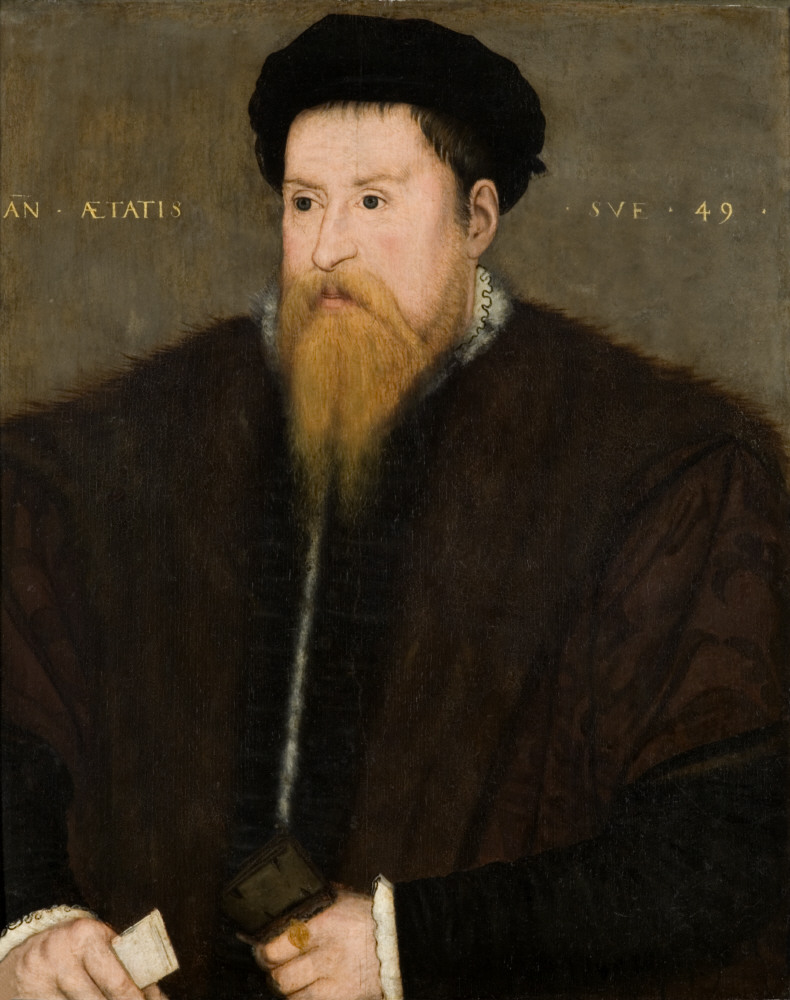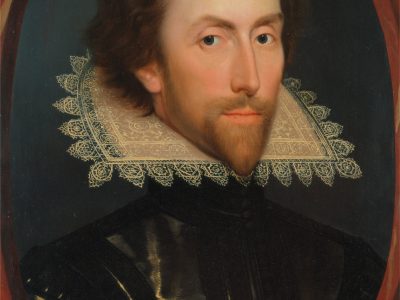Hidden potential at Coughton Court by Rebecca Farr

Sir Nicholas Throckmorton (1515-1571), aged 49, by British (English) School, 1564, oil on panel. Coughton Court, Warwickshire © National Trust Images/John Hammond. This is Coughton Court's earliest portrait.
It’s time to confess: I know very little about portraits. I don’t have a degree in Art or History. My degree is in English, and my background is conservation, so I will apologise in advance if I appear easily pleased by the things I learnt when I attended my first Understanding British Portraits workshop! My role at Coughton Court is based mostly in collections care and researching and interpreting our broad range of beautiful items for the visiting public. The 600-year-old Coughton Court, ancestral seat of the still-resident Throckmorton family, has a large collection of items spanning the centuries, including around one hundred family portraits and miniatures. At present we do not make any more of a feature of these paintings than a simple laminate giving detail of dates and sitters. So it was pleasant but not wholly unexpected when it was suggested I attend Understanding British Portrait’s workshop, ‘The Real Tudors’ to find out more about our portraits’ as yet unrealised potential.
I found the workshop to be particularly interesting for a number of reasons. Firstly, because it involved meeting a wide range of other museum professionals from different institutions and departments: curators, conservators, researchers, and operational staff such as me. It was fascinating to see the variety of subjects being researched, and their different takes on potential display and interpretation. It has flagged up to me additional areas of research that we could undertake to uncover more information about our portraits, such as the details and style of the sitter’s dress, or the symbolism within the portrait. Also the resources available at the National Portrait Gallery and the Heinz Archive were a revelation; portraits about which we know little or nothing might one day have some light shed upon them – how exciting!
Clare McLaren-Throckmorton (b. 1935) by Sergei Pavlenko (b.1953), 1996. Coughton Court, Warwickshire © National Trust Images.
This is Coughton Court’s most recent portrait.
Secondly, the subject of the workshop itself. ‘The Real Tudors’ was particularly pleasing to me as it was interpreting the paintings in relation to one another, following on chronologically from one monarch to the next. Coughton Court’s paintings are arranged throughout the house in this style. As you begin your journey at the bottom of the main staircase you will see the earliest Throckmorton family portraits continuing up the staircase and beyond in this manner, in a vertical family tree. The first portrait, of Sir Nicholas Throckmorton (top left), we believe dates from 1564, while the last portrait of the current resident family member, Mrs McClaren-Throckmorton (above), was painted over 400 years later in 1996. I particularly liked the decision to anchor each of the Tudor monarchs with a tangible item, such as their signature: this directly connected their image with their life, reminding us that they were real people, not just stories. In 600 years of history spread over a country house, it can be difficult to retain a sense of who the person in the painting is - especially when they are not so well-known to our visitors as Henry VIII and Elizabeth I - and this concept of making a connection of portrait to physical item is something we would like to build on going forwards.
Sir Nicholas Throckmorton (1515-1571), aged 49 by British (English) School, inscribed 1564, oil on canvas. Coughton Court, Warwickshire © National Trust Images/John Hammond.
A later copy of Coughton Court’s earliest portrait; we know very little about this copy.
I was also fascinated by ‘The Real Tudors’ direct comparison of portrait copies, and the scientific analysis used to discover differences and assist in the dating of the portraits. Coughton Court only has one copy of a portrait (above), after the previously mentioned Sir Nicholas Throckmorton. We know very little about this painting; how much later it was painted, by whom, and for whom are all current mysteries. With some further research, I think it would be fascinating to do a direct comparison between the two paintings and flag up the many differences!
Another application of this scientific analysis that I would particularly love to do at Coughton Court –daring to dream- is in connection with our unique Tabula Eliensis (below). Whilst technically not a portrait, this large oil on linen painting depicts over a hundred knights, priests and English monarchs from Canute to Elizabeth I, all in miniature roundels. This panel was painted in 1596, and only discovered rolled up and forgotten in the roof space at Coughton Court in the early 1900s. The reason for its unusual storage location is most probably the very nature of its content; the Tabula Eliensis depicts, below the image of Ely Cathedral from which it takes its name, and those many roundels, the heraldic arms of all the families imprisoned for recusancy under the reign of Elizabeth I. Unsurprisingly the coat of arms of the devout Catholic Throckmorton family appears twice. This is a dangerous item to have in your house in an age of executions and priest-hunters. This panel is unsurprisingly in a sorry state, although now in a stable condition, and there has been a great deal of paint loss over the centuries, and due to the sheer size of the panel it is difficult to make out details with the naked eye. The techniques used in ‘The Real Tudors’ to capture clear high-resolution images of the item, as well as uncovering earlier layers which had been painted over gives me hope that one day there will be a chance to see some of the lost details that the Tabula Eliensis is hiding.
The Tabula Eliensis, a painted canvas dated 1596 in The Tower Room at Coughton Court, Warwickshire © National Trust Images/John Hammond.
Detail from the Tabula Eliensis, a painted canvas dated 1596 in The Tower Room at Coughton Court, Warwickshire © National Trust Images/John Hammond.
There is definitely unrealised potential in our portraiture at Coughton Court. ‘The Real Tudors’ workshop has given me a crash course in what can be done to bring these items to life, and I would love to undertake further research and employ some of the techniques and inspiration I have discovered in our own collection. I’ll definitely be watching out for further UBP workshops!

